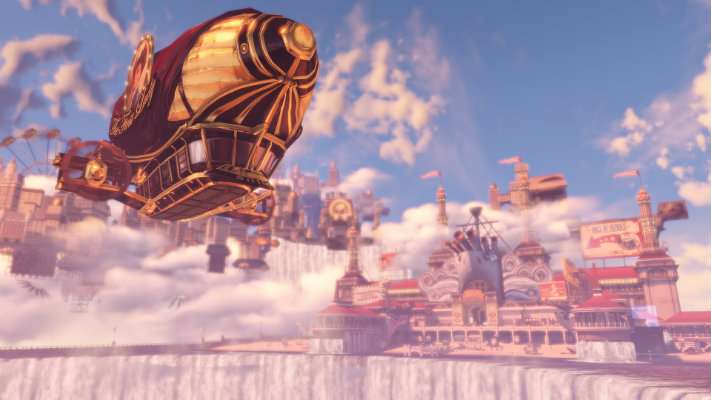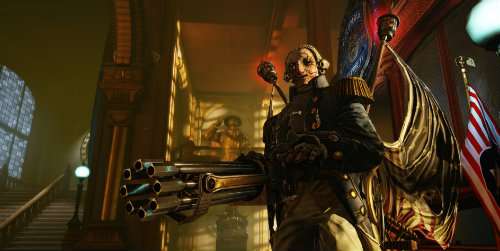The Infinite World of Bioshock
Bioshock Infinite makes a strong case that video games can be great pop art.

Bioshock Infinite may or may not be the single best game released for today's video game systems, but it is without a doubt among the greatest. Like its 2007 predecessor, Bioshock, it is a gorgeous and involving triumph of interactive narrative and world building, rich in character and knotty political and philosophical ideas. The original made for a promising opening to the next six years of big-budget, mass-market video games; now Bioshock Infinite offers a fitting capstone to the console generation set to end this year. Just as the first Bioshock became a touchstone in the ongoing arguments about whether video games can be art, Bioshock Infinite ought to close the door on any remaining debate.
The visuals alone ought to be enough. Video game art direction is consistently strong these days—even essentially mediocre games such as Hitman Absolution and Dead Space 3 are visually impressive. Even still, Bioshock Infinite stands out for its inventive and frequently gorgeous world-building.
Infinite's world offers a twist on the one found in its predecessor. The first game took players through Rapture, a mostly abandoned undersea city set in 1960. The sci-fi Art Deco vibe gave the game a mix of kitschy humor and retro grandeur—it was both amusing and awe inspiring. Bioshock Infinite once again offers a vivid retro-inspired city to play in, but this one is set in the sky: a huge, floating city called Columbia.
Like Rapture, Columbia is a city founded on a political ideal, and led by a visionary leader. Rapture was the product of an experiment in aggressive Darwinian capitalism, led by a man named Andrew Ryan—an Ayn Rand-inspired figure who throughout the game preaches the virtues of will and self-reliance. Columbia is a turn-of-the-century secessionist colony founded on an idealized vision of American exceptionalism by one Zachary Hale Comstock—a man who calls himself "The Prophet."
Bioshock Infinite's city in the clouds is flat-out gorgeous—sun-speckled and majestic, filled with strange details and breathtaking sights. Your visit to the city opens in a courtyard featuring giant-sized monuments to America's founding fathers; a few moments later, you witness a floating parade in which a barbershop quartet gently sings a Beach Boys tune (don't worry—all will be explained by the end).
But the beauty of the world isn't what makes the game truly great. Instead, it's the narrative opportunities the world offers—and the highly effective way the game capitalizes on them.
Lots of video games look great these days, but very few have characters or stories worth a damn. Bioshock Infinite's narrative is smarter and more engaging than most of the movies released so far this year, and as good or better than a lot of the genre novels it draws from.

Much like the first Bioshock, which toyed with game-friendly notions of individual decision making and self-determination, the big ideas in Infinite all riff on video game conventions of choice and control. Without getting too heavily into spoiler territory, it's enough to say that, like so many contemporary video games, which offer players endless opportunities to tweak the looks and capabilities of their characters, Bioshock Infinite is built around the question of who you choose to be. But unlike so many of its peers, which superficially fetishize the idea of choice but rarely offer players much much more than a slightly different set of magic hats to wear, Infinite doesn't view its central question in a mechanistic way. Instead, it forces players to confront the potentially cruel consequences of even seemingly benign actions, beliefs, and identity choices—both for individuals and the worlds they create.
Ironically, one of the biggest complaints amongst players of the game seems to be that it offers too few meaningful choices. It's a criticism that misses the game's whole point—which is that many of the choices we think matter most don't matter much at all, and that our lives are often determined by choices we don't understand, many of which are grounded in complex social and political histories that began long before the lives they shape.
But don't worry if this sounds too dense—this is a video game, not a philosophy lesson or a history lecture. I loved playing every minute of Bioshock Infinite, and I was thoroughly gripped by both the story and the minute-to-minute challenges of gameplay at just about every moment (I especially enjoyed taking down Motorized Patriots—giant robot versions of America's Founding Fathers, complete with heavy weaponry). It is, in virtually every way, a powerful example of what video games can and arguably should be—an entertaining, involving, and even thought-provoking piece of pop art.
But what games should be, of course, is not always what they are. And if I came away with a nagging worry, it's that it took so long to produce a worthy follow-up to the mix of game and narrative ideas in the original (a quickie 2010 sequel was a fun but not particularly memorable rehash produced under a license by a different game development studio). It's been six years since the original, and Bioshock Infinite feels like a major step forward from its predecessor, but not a giant leap. It's a game that offers plenty of evidence that games can be art—but it also serves as a reminder that too few of them are.